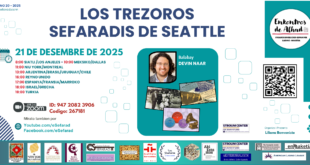By KEN JOHNSON
Trick question: What world-changing event happened in 1492 involving Queen Isabella of Spain? If you answered, “The Jews were expelled from Spain by edict of the queen and her husband, Ferdinand II,” you probably have an uncommonly high history I.Q. You probably also know that Isabella and Ferdinand had started the Spanish Inquisition 14 years earlier in an effort to ferret out Jews who had ostensibly converted to Christianity but continued to practice Judaism in secret.

These events are telling historical markers in the background of an exhibition at the Museum of Biblical Art, near Lincoln Center, addressing a topic that was not explored much — or even widely thought to exist — until about 20 years ago: Jewish participation in the Spanish visual arts in the two centuries prior to the expulsion.
Organized by Vivian B. Mann, director of the master’s program in Jewish art at the Graduate School of the Jewish Theological Seminary, “Uneasy Communion: Jews, Christians and the Altarpieces of Medieval Spain” represents a momentous turn in scholarly thought about Spanish art, and it sheds light on a fascinating chapter in the history of the Jewish diaspora.
Though it’s not a blockbuster, there are some impressive works among the 32 objects on view. They range from a near-mural-scale assemblage of panels — called a retablo — depicting in detail scenes from the life of the Virgin by Pere Espalargues to a paperback-book-size illuminated manuscript version of “Guide for the Perplexed” by the Jewish philosopher Maimonides.
The exhibition’s purpose is historical rather than aesthetic, however. Its contents are offered mainly as evidence of Jewish contributions to Spanish art and, more broadly, for what they tell us about Jewish life in general in late medieval Spain.
It is a complicated topic, and you cannot fully appreciate the show without reading the catalog essays. For starters, the historian Thomas F. Glick explains that contrary to popular belief, Jews were not isolated from the rest of society and beholden only to Talmudic law. The situation that prevailed has been called “la convivencia” — a multicultural, more or less peaceful commingling of Christians, Muslims and Jews.
Jews lived in separate communities, but there were many Jewish converts to Christianity (“conversos”), and there was a great deal of interaction between Jews and the larger community along legal, economic, scholarly, scientific and artistic lines. There were pogroms and other terrible acts of prejudice against Jews, but anti-Semitism was precipitated partly because Jews seemed to their persecutors to be disproportionately successful in their dealings with the Christian world.
While nothing in the exhibition has been attributed to a known Jewish artist, Ms. Mann points out in her essay that contracts between patrons and artists prove that Jewish artists produced works for Christian as well as Jewish consumption. Evident awareness of particular Judaic customs in some paintings in the show, she contends, suggests that practicing Jews or conversos probably were involved in the workshops that produced them. For example, an early-15th-century painting by an unknown artist illustrating the boy Jesus impressing the doctors in a synagogue accurately represents what the interior of a medieval synagogue looked like. (On the other hand, there were Christians who took a more-than-casual interest in Jewish culture, so it is hard to say what such visual evidence really demonstrates beyond appearances.)
The dark side is visible in many paintings too. A large, extraordinarily dramatic panel painting called “St. Helena Interrogating Judas,” by Miguel Jiménez and Martín Bernat around 1485-87, just a few years before the expulsion, depicts a legendary scene in which St. Helen questions a kneeling and weeping Jewish man who is believed to know where the true cross of Jesus is buried. This supposedly happened a thousand years earlier, but the luxurious clothing styles of St. Helen and others who crowd the picture are contemporary; the unfortunate detainee wears a dark cloak as per governmental regulations of the time. Ms. Mann notes that this updating of an old legend would have been understood as an allusion to the Inquisition.
If parsing old paintings for signs of Jewish life sounds a little pedantic, then you must read the catalog essay by Marcus B. Burke, the curator of paintings, drawings and metalwork at the Hispanic Society of America in New York. Mr. Burke writes that awareness of Jewish contributions to Spanish culture was suppressed until recently by deeply persistent anti-Semitism.
In the 20th century the officially Roman Catholic Franco regime discouraged interest in Spain’s Jewish heritage. (In fact, the Edict of Expulsion was not formally revoked until 1968.) Coincidentally, the Modernist approach to art history demanded a connoisseurial focus on style and form without regard for the sorts of social and political aspects that art historians today commonly study. Conventional wisdom even up to the early 1980s was that Jews had no consequential influence on Christian painting in medieval Spain.
The “sea change,” notes Mr. Burke, came in 1992 when the Jewish Museum mounted “Convivencia” at the New-York Historical Society, an exhibition for which Ms. Mann was a curator, that explored Jewish contributions to all the arts in medieval Spain. Now, he observes, papers on Jewish topics are regularly delivered at conferences on medieval Spanish art.
As researchers continue to uncover evidence of Jewish involvement in Spanish culture and society, we may pause to consider one of those huge, historical what-ifs: Suppose the Inquisition had fizzled, and the 200,000 Jews who were expelled from Spain and its territories had been allowed to remain and prosper?
“Uneasy Communion: Jews, Christians and the Altarpieces of Medieval Spain” is on view through May 30 at the Museum of Biblical Art, 1865 Broadway, at 61st Street; (212) 408-1500; mobia.org.
Fuente: The New York Times
 eSefarad Noticias del Mundo Sefaradi
eSefarad Noticias del Mundo Sefaradi

